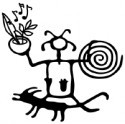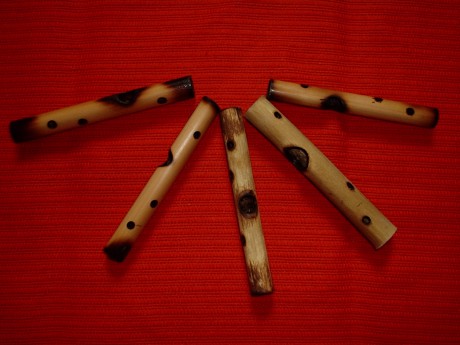Inanga

Něco o tomto nástroji (rozhlasový pořad Vlastislava Matouška):
http://www.shakuhachi.cz/dilo/media/25Inanga.mp3
Inanga
In organology the inanga is known as a ‘trough-zither’, which gives an indication of the shape of the instrument, namely a flat soundboard (resonator) with slightly concave sides reminiscent of the shape of a trough or raft. It varies from 75 to 115 cm in length and 25 to 30 cm in width. The soundboard itself is slightly smaller as there is a rim all around it. At the narrow ends the rim is much wider and has eight to twelve deep notches cut into each end to hold the strings in place. One striking feature is that not all the notches have a string, so that the number of strings is always smaller than the number of notches. The preference is for instruments with six to eight strings, and this group accounts for nearly 90% of all inanga.
The soundboard has two types of decoration: star-shaped or oval incisions, ‘the eyes of the inanga’, the function of which is to distribute the sound, and burnt-in geometric motifs on the ends of the instrument. The strings of the inanga are made from natural fibres, and used to be made from animal gut. The person who works the hides into clothes is responsible for producing strings of animal origin. Each instrument actually has a single continuous string, which is stretched from one end of the soundboard to the other and looped through the notches, resulting in several strings. The rest of the string is fastened to a wooden peg. A protective strip is sometimes placed between the strings and the rim of the soundboard to prevent the tightly stretched strings from getting damaged. Nowadays nylon or metal strings are also used.
The performer remains seated while he plays, resting the inanga vertically on his lap. Holding the instrument with the little finger of his left hand, he uses the other fingers of his left hand to pluck the top four strings and the fingers of his right hand to pluck the bottom four strings. The strings are plucked using the fingertips. Only open strings are used, hence one fixed note is produced for each string. One technique sometimes used, however, is to lightly touch the string at certain points and then pluck it to produce harmonics. Tapping on the soundboard with the fingernails adds to the rhythmic sound.
The inanga is usually played solo and the performer sings his own songs about historical events, personal experiences or everyday incidents. The inanga is also played during rituals. The Twa seldom use the trough zither. In some cases it may also be played by a woman.
The range of the instrument is usually anhemitonic pentatonic, which means that not all of the six to nine strings are used. Tuning is carried out by tightening the string slightly (higher notes) or loosening it (lower notes).
For more information consult the following publications edited by the RMCA:
- GANSEMANS, J. Les instruments de musique du Rwanda. Étude ethnomusicologique, Annales RMCA n° 127, 361 pp. + 102 photos
- Compact Disc :
- Rujindiri, maître de l’inanga (fmd 186)
- RWANDA : Polyphonie des Twa (fmd 196)
- Musiques du Rwanda (fmd 206)
© KMMA/Jos GANSEMANS

